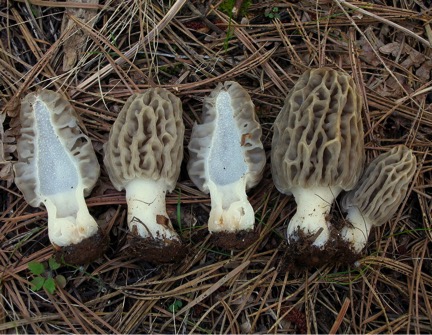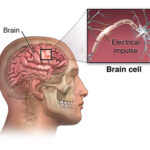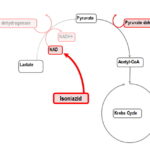Mushroom poisoning from gyromitrin-containing species, notably Gyromitra esculenta (false morel), is a rare but severe toxicological emergency. The ingestion of these mushrooms can lead to a constellation of symptoms, among which generalized tonic-clonic seizures are among the most alarming. The underlying pathophysiology involves gyromitrin metabolism into monomethylhydrazine (MMH), a potent neurotoxin that interferes with central nervous system (CNS) function, particularly by reducing levels of gamma-aminobutyric acid (GABA), a major inhibitory neurotransmitter in the brain.

Toxicology of Gyromitrin and Monomethylhydrazine (MMH)
Metabolic Pathway and Neurotoxic Mechanism
Once ingested, gyromitrin is hydrolyzed in the gastrointestinal tract to produce MMH. This compound exerts its toxic effects via several mechanisms:
- Inhibition of GABA Synthesis: MMH inhibits glutamic acid decarboxylase (GAD), the enzyme responsible for converting glutamate to GABA. This results in decreased inhibitory neurotransmission.
- Oxidative Stress and Hepatotoxicity: MMH also produces free radicals, leading to lipid peroxidation, liver injury, and systemic oxidative damage.
- Interference with Pyridoxine (Vitamin B6): MMH inactivates pyridoxine, a cofactor essential for GABA synthesis, further exacerbating CNS hyperexcitability.
Clinical Presentation of Gyromitrin Poisoning
Symptoms of gyromitrin poisoning typically manifest within 6 to 12 hours post-ingestion and progress through several phases:
1. Gastrointestinal Phase (6–12 Hours)
- Nausea
- Vomiting
- Abdominal cramps
- Diarrhea
2. Systemic Toxicity Phase (12–48 Hours)
- Lethargy and confusion
- Jaundice (from hepatic involvement)
- Methemoglobinemia (rare but possible)
3. Neurological Phase (24–72 Hours)
- Generalized tonic-clonic seizures
- Tremors
- Delirium
- Coma (in severe cases)
Children and individuals with hepatic compromise are particularly vulnerable to rapid CNS deterioration.
Diagnosis of Seizure from Gyromitrin Mushroom Ingestion
Diagnosis is clinical and based on history of recent foraging or ingestion of wild mushrooms. Confirmation involves:
1. Patient History and Identification
- Inquiry about wild mushroom consumption
- Identification of mushroom species, preferably by a mycologist or via photograph
2. Laboratory Testing
- Liver function tests (AST, ALT, bilirubin)
- Coagulation profile (PT/INR)
- Serum electrolytes and glucose (rule out hypoglycemia)
- Arterial blood gas (evaluate metabolic acidosis)
- Blood ammonia levels
- Complete blood count
3. Neurodiagnostic Evaluation
- EEG (often shows diffuse epileptiform activity)
- Brain imaging (CT/MRI if seizures persist to rule out other pathology)
Management and Treatment Strategies
There is no specific antidote for gyromitrin poisoning. Management is primarily supportive, with seizure control and hepatoprotection being the pillars of care.
Seizure Management
- First-line therapy: Benzodiazepines (e.g., lorazepam or diazepam)
- Adjunctive therapy: Levetiracetam or phenytoin if seizures are refractory
- Status epilepticus: Continuous infusion of midazolam or propofol may be required
Pyridoxine (Vitamin B6) Therapy
- Administered IV in doses of 25–50 mg/kg (up to 5 g total)
- Restores GABA synthesis by reactivating GAD enzyme
- Particularly effective if given early in CNS symptom onset
Gastrointestinal Decontamination
- Activated Charcoal: If within 1–2 hours of ingestion
- Gastric lavage: Rarely used, only in large ingestions
Hepatic and Renal Support
- IV fluids for hydration and renal protection
- N-acetylcysteine (NAC) as hepatoprotective in cases of elevated transaminases
- Monitoring for signs of hepatic failure
Prognosis and Long-Term Sequelae
The prognosis depends on the quantity ingested, delay to treatment, and patient age. With timely intervention and supportive therapy, full recovery is achievable in most cases. However, in cases with prolonged seizures or hepatic failure, outcomes may include:
- Cognitive impairment
- Chronic liver dysfunction
- Death (in severe untreated exposures)
Prompt recognition and early administration of pyridoxine significantly improve survival rates.
Prevention of Gyromitrin-Related Seizures
Public Education
- Avoid foraging mushrooms without expert identification
- Awareness campaigns on the toxicity of false morels and similar species
Regulatory Measures
- Prohibition of wild mushroom sales without proper classification
- Surveillance of seasonal poisoning outbreaks in endemic regions (e.g., Scandinavia, Eastern Europe, North America)
Clinical Vigilance
- Inclusion of mushroom toxicity in differential diagnosis of new-onset seizures
- Education of emergency physicians and toxicologists on early intervention protocols
Gyromitrin-containing mushroom poisoning remains an uncommon but potentially fatal cause of seizure disorders. The neurotoxic effects of MMH through GABA inhibition and oxidative stress lead to profound CNS excitation, resulting in seizures and encephalopathy. Timely administration of pyridoxine and aggressive seizure management form the foundation of treatment. Awareness among clinicians and the general public is critical to prevent morbidity and mortality from this preventable toxicological syndrome.

